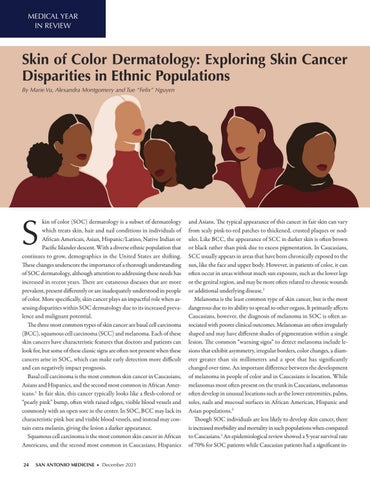MEDICAL YEAR IN REVIEW
Skin of Color Dermatology: Exploring Skin Cancer Disparities in Ethnic Populations By Marie Vu, Alexandra Montgomery and Tue “Felix” Nguyen
S
kin of color (SOC) dermatology is a subset of dermatology which treats skin, hair and nail conditions in individuals of African American, Asian, Hispanic/Latino, Native Indian or Pacific Islander descent. With a diverse ethnic population that continues to grow, demographics in the United States are shifting. These changes underscore the importance of a thorough understanding of SOC dermatology, although attention to addressing these needs has increased in recent years. There are cutaneous diseases that are more prevalent, present differently or are inadequately understood in people of color. More specifically, skin cancer plays an impactful role when assessing disparities within SOC dermatology due to its increased prevalence and malignant potential. The three most common types of skin cancer are basal cell carcinoma (BCC), squamous cell carcinoma (SCC) and melanoma. Each of these skin cancers have characteristic features that doctors and patients can look for, but some of these classic signs are often not present when these cancers arise in SOC, which can make early detection more difficult and can negatively impact prognosis. Basal cell carcinoma is the most common skin cancer in Caucasians, Asians and Hispanics, and the second most common in African Americans.1 In fair skin, this cancer typically looks like a flesh-colored or “pearly pink” bump, often with raised edges, visible blood vessels and commonly with an open sore in the center. In SOC, BCC may lack its characteristic pink hue and visible blood vessels, and instead may contain extra melanin, giving the lesion a darker appearance. Squamous cell carcinoma is the most common skin cancer in African Americans, and the second most common in Caucasians, Hispanics 24
SAN ANTONIO MEDICINE • December 2021
and Asians. The typical appearance of this cancer in fair skin can vary from scaly pink-to-red patches to thickened, crusted plaques or nodules. Like BCC, the appearance of SCC in darker skin is often brown or black rather than pink due to excess pigmentation. In Caucasians, SCC usually appears in areas that have been chronically exposed to the sun, like the face and upper body. However, in patients of color, it can often occur in areas without much sun exposure, such as the lower legs or the genital region, and may be more often related to chronic wounds or additional underlying disease.1 Melanoma is the least common type of skin cancer, but is the most dangerous due to its ability to spread to other organs. It primarily affects Caucasians, however, the diagnosis of melanoma in SOC is often associated with poorer clinical outcomes. Melanomas are often irregularly shaped and may have different shades of pigmentation within a single lesion. The common “warning signs” to detect melanoma include lesions that exhibit asymmetry, irregular borders, color changes, a diameter greater than six millimeters and a spot that has significantly changed over time. An important difference between the development of melanoma in people of color and in Caucasians is location. While melanomas most often present on the trunk in Caucasians, melanomas often develop in unusual locations such as the lower extremities, palms, soles, nails and mucosal surfaces in African American, Hispanic and Asian populations.2 Though SOC individuals are less likely to develop skin cancer, there is increased morbidity and mortality in such populations when compared to Caucasians.3 An epidemiological review showed a 5-year survival rate of 70% for SOC patients while Caucasian patients had a significant in-








